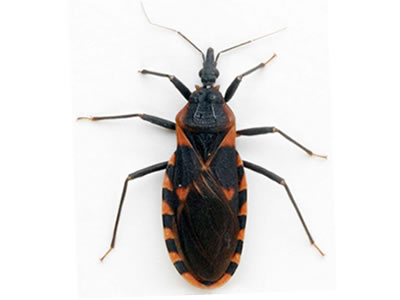Chagas Disease (Chagas’ disease, American trypanosomiasis, “The New AIDS of the Americas”) is a tropical parasitic disease that is common in South and Central America, and now the disease is a growing problem in North America and Europe. According to the report “Medical Encyclopedia: Chagas disease” published in 2008 by National Institutes of Health, approximately 300,000 infected people live in the United States, which is likely due to immigration from Latin American countries.
What is Chagas Disease
Chagas Disease was named after the Brazilian doctor Carlos Chagas, who first described the disease in 1909. This infection is caused by a protozoan parasite named Trypanosoma cruzi, which is commonly transmitted to humans by an insect vector “kissing bug” of the subfamily Triatominae. The bug bites and sucks the blood of its sleeping victim, and defecates on the person. Triatomines pass T. cruzi parasites (called trypomastigotes) in the body. Once inside the body, the trypomastigotes invade cells, and gradually destroys heart tissue and the gastrointestinal tract. It typically causes chronic symptoms such as cardiac arrhythmias, poor gastrointestinal motility, etc.
Chagas disease has two stages: acute and chronic. In the early, acute stage, the patient may have no symptoms or have very mild symptoms, typically, swelling and reddening at the site of infection. After 1-2 months, the patient with active infections enters the chronic stage. In chronic stage, the disease affects the nervous system, digestive system and heart. In the chronic stage, about 2/3 of people have cardiac damage, including dilated cardiomyopathy, which causes heart rhythm abnormalities and may result in sudden death. About 1/3 of people likely develop digestive system disorders, such as megacolon, megaesophagus, severe weight loss, swallowing difficulties, and malnutrition.
Modern Treatment of Chagas Disease
According to the WHO, there are two antiparasitic drugs benznidazole and nifurtimox that are effective to treat Chagas disease. If the two drugs are used in the early, acute stage, the cure rates can be up to 90%. But both drugs often have side effects, which may include: headaches, dizziness, loss of appetite, etc.
Herbal Remedies for Chagas Disease
Native Americans used herbs to treat symptoms of Chagas disease for centuries. The Kallawayas of Midwestern Bolivia were using guayusa, and sayre with an enema syringe to purge patients as early as A.D. 400. Even today, they still use wild tobacco as an effective vermifuge and parasiticide remedy. Sniffing tobacco and guayusa helps cleanse the passageways by causing sneezing, and the nicotine in tobacco also stimulates the cardiovascular system when it enters the bloodstream. The remedies can relieve some of the effects of chronic Chagas disease.
Nicolas Carrasco, a Bolivian herbal doctor, used a herbal remedy called “Regenerator” to cure Chagas disease. The remedy contains a resin from the fruit of the Rotan palm tree (Calamus drago), called Sangre de Drago (Blood of the Dragon). The plant’s seeds are toasted, crushed, added to a small glass of pisco liquor, and drunk daily. The remedy purges the body of toxic fluids, warms body and expels cold-dampness in blood. The fresh seeds contain acetic acid, butyric acid, glyceride, and castor oil, which form a powerful purgative. This remedy is used against the constipation sometimes caused by the infestation of T. cruzi parasites in the intestine.
Jaime Zalles, a contemporaneous Bolivian herbalist, treats chagasic heart disease with three flowers of retama in a mate (steeped in hot water), with two leaves of cedron (Lippia triphylla). The remedy is used as a tranquilliser for heart attacks. Toronjil Melissa officinalis L. is also used for heart problems associated with Chagas disease.
Warnings
Please note, Chagas disease is a severe disease. If you are affected by the disease, you should seek medical care immediately, visiting your doctor, and taking a treatment without a delay. Although the natural herbal remedies might help improve the symptoms of chronic Chagas disease, but the cures have not been validated by modern medicine studies.
References
- Chagas disease, Wikipedia website, en.wikipedia.org/wiki/Chagas_disease
- Kirchhoff LV. Trypanosoma species (American trypanosomiasis, Chagas’ disease): Biology of trypanosomes. In: Mandell GL, Bennett JE, Dolin R, eds. Principles and Practice of Infectious Diseases. 7th ed. Philadelphia, Pa: Elsevier Churchill Livingstone; 2009: chap 277
- Control of Chagas’ disease through a Cultural Context Model: Proyecto Britanico Cardenal Maurer in Sucre, Bolivia, www.unesco.org/most/bpik22-2.htm



